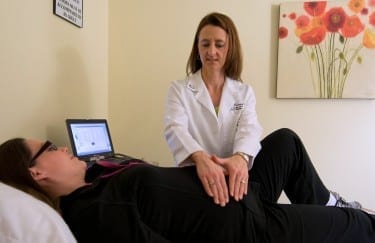
Pelvic pain during pregnancy is a common occurrence. Approximately 20 percent of women have pelvic girdle pain at some point during their pregnancy. Pelvic pain is most frequently located in the front over the pubic bone, below the stomach or across one or both sides of the lower back. Most pregnancy-related pain is due to a combination of factors causing instability in the joints, muscle imbalances and rapid changes to the body. The symptoms can occur any time during pregnancy or even after delivery. The severity of the discomfort is variable for each person. It can range from mild to severe and may limit the ability to move around. The pain is frequently more noticeable when an asymmetrical or unbalanced position occurs such as when standing on one leg (like when getting dressed), walking, going upstairs, turning over in bed or moving your legs apart (like when getting out of a car).
The good news is physical therapy can help improve your pain and restore your function. Many people think that having pain during pregnancy is unavoidable but this is a common myth! By addressing the underlying issues causing pain, you can have an enjoyable pregnancy and an easier delivery.
The DMU Physical Therapy Clinic can help! Schedule an appointment by calling 515-271-1717, Monday through Friday, 8 a.m. to 5 p.m.

